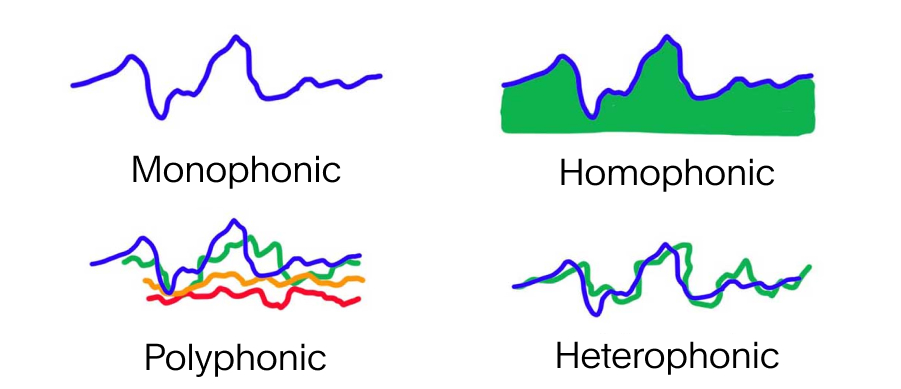Music texture refers to the way that different sound layers are combined in a musical piece to create a sense of depth and richness. The texture of a piece of music is influenced by factors such as the number of voices or parts, their relative strengths, and the relationships between them.
Types of music textures
There are several types of musical textures that are commonly used, including:
- Monophonic: This texture is made up of a single melodic line, with no harmony or accompaniment. An example of this type of texture is Gregorian chant.
- Polyphonic: This texture is made up of two or more melodic lines that are independent but harmonically connected. An example of this type of texture is a fugue.
- Homophonic: This texture is made up of a single melodic line, accompanied by chords that harmonize with it. This type of texture is common in pop and rock music.
- Heterophonic: This texture is made up of two or more versions of the same melody being played at the same time, but with slight variations in rhythm or pitch. An example of this type of texture is a traditional folk melody.
- Textural: This texture is made up of a combination of different musical elements, such as rhythm, melody, and harmony. An example of this type of texture is found in ambient or electronic music.
Music texture can have a profound impact on the overall feel and atmosphere of a piece of music. A dense, complex texture can create a feeling of tension or intensity, while a sparse texture can create a feeling of calm or simplicity.

Musical layering
In addition to the type of texture, the way that different musical elements are layered can also affect the overall sound of a piece of music. There are several ways that music elements, such as melody, harmony, rhythm, timbre, and dynamics, can be layered to create a rich and complex texture in a piece of music. Some of these ways include:
- Overlapping: This involves playing multiple musical elements at the same time, such as a vocal melody and an accompanying harmony.
- Layering: This involves adding one musical element on top of another, such as adding a layer of percussion to an existing melody and harmony.
- Counterpoint: This involves combining two or more independent melodic lines in a way that creates a harmonious and pleasing effect.
- Canon: This involves repeating a melodic line, with each iteration starting at a different time and overlapping the previous one.
- Ostinato: This involves repeating a rhythmic pattern or melody in a piece, creating a sense of stability and structure.
- Call-and-response: This involves alternating between two or more musical elements, such as a singer calling out a phrase and the band responding with a different phrase.
- Theme and variation: This involves taking a musical idea, such as a melody, and changing it in various ways, such as changing the rhythm or harmony, to create a new and different sound.
- Imitation: This involves one musical element mimicking another, such as a flute playing a melody that was just played by a violin.
The way that musical elements are layered can greatly affect the overall sound and feel of a piece of music. By exploring different techniques and combinations, musicians can create a vast array of textures, from simple and straightforward to complex and intricate.
Music textures to enhance songwriting and productions
Music texture is a powerful tool for enhancing the production value of music. By understanding the various ways that different musical elements can be layered and combined, you can use texture to create different moods and atmospheres, support the lyrics and themes of your songs, and add depth and richness to your music. Here are a few tips for using music textures to enhance your productions:
- Experiment with different textures: Try combining different musical elements in new and creative ways, and see how they interact to create different textures. Experiment with different combinations of melody, harmony, rhythm, timbre, and dynamics.
- Use contrast: By contrasting different textures, you can create dynamic and interesting musical arrangements. For example, you might use a sparse and simple texture in the verses and a denser and more complex texture in the choruses.
- Create movement: By changing the texture throughout a song, you can create movement and tension, and keep the listener engaged. For example, you might start with a simple and straightforward texture, and gradually build to a more complex and layered texture.
- Use texture to support lyrics and themes: The texture of your music can greatly affect the emotional impact of your lyrics and themes. For example, a sparse and delicate texture can create a feeling of vulnerability, while a dense and complex texture can create a feeling of intensity.
- Experiment with different instruments and sounds: Try using different instruments and sounds to create different textures. Experiment with different combinations of acoustic and electronic instruments, and use sound design techniques, such as effects and processing, to create unique and interesting textures.
By incorporating these tips into your productions, you can use music texture to enhance the overall sound and impact of your music. Whether you’re working on a full album or just a single song, paying attention to texture can help you to create more engaging and dynamic musical compositions.
In conclusion, music texture is an important aspect of music composition and production, and it is essential for musicians and listeners to understand its various elements and how they interact to create the overall sound of a piece of music. Whether you’re a beginner or an experienced musician, learning about music texture can deepen your appreciation for the art form and help you to create more interesting and dynamic musical pieces.






 50 Industry Music Production Tips You Must Know
50 Industry Music Production Tips You Must Know




